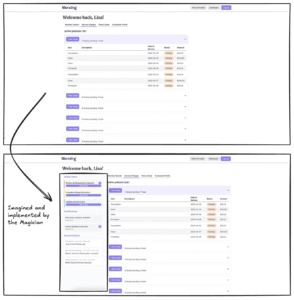“The ability to quickly build out new React components that feel integrated with our existing codebase is very helpful for making design and development decisions quickly and easily.”
— Conner Gillette, Software Engineer at Mending
Mending, a fast-moving healthcare technology company, needed a way to keep its product UI polished and evolving — without constantly pulling engineers off core roadmap work. Like many startups, they faced tension between building new features and maintaining the quality of existing ones. That’s where Autonomy’s Magician agent came in.
By leveraging AutonomyAI’s Magician agent, Mending was able to ship faster, improve visual consistency, and make high-confidence changes in parts of the codebase that would otherwise be avoided. What made the difference? The agent didn’t start from scratch — it worked directly from existing files, applying smart updates in context.
What is the Magician Agent?
Most design-to-code tools expect you to start from a blank canvas — creating new components from scratch and wiring them in yourself. But the Magician Agent flips the script. It’s not limited to net-new work — it can refine, extend, and restructure your actual codebase.
Think of it as a growing set of spells tailored to the way real teams work: whether you’re polishing a design, adding new functionality to a screen, refactoring a legacy component, or building something from scratch — the agent can handle the task with context awareness and high-quality implementation.
This fills a massive gap in modern dev workflows. Teams often avoid touching legacy components or ignore visual polish tasks because the cost of context-switching is too high. The Magician agent changes that. It already knows your repo, your components, and your standards — and can make smart, production-ready improvements in seconds.
Where the Agent Made a Difference at Mending
Each of the following examples shows how the agent delivered meaningful value in a real-world dev workflow.
1. Polishing Visuals with Brand Alignment
What the agent did: Updated styling on various UI components to reflect Mending’s latest brand guidelines — including font weight, spacing, and color schemes.
Why this mattered: These types of changes — which we call low ROI tasks — are important, but rarely urgent. Teams know they should be done, but they often get pushed down the backlog because the effort (spinning up local environments, finding the right file, manually tweaking CSS) doesn’t feel worth it for a small visual gain.
The Magician agent changed the equation. The team simply assigned the task — something that would normally fall to the bottom of the backlog — and the agent handled the update directly in code. No manual tweaking, no design reviews, no need to interrupt engineers working on core features. As a result, the UI became more polished and consistent across the product — all without slowing down development velocity.
✨ The Magician agent unlocks “low ROI” work that actually matters: elevating polish, consistency, and brand alignment without draining team resources.
2. Prototyping and Experimenting in Code, Not Slides
a) Testing a New Feature Concept
What the agent did: Implemented a high-fidelity Activity Panel directly in Mending’s codebase — not as a static mockup, but as an interactive, visually realistic component scaffold. With only a short, high-level description (the feature was still in the ideation phase), the agent inferred layout, structure, and behavior. It reused real components from Mending’s design system and generated mock data and dummy interactions to simulate what a finished version could look and feel like.
Why this mattered: Instead of following the typical flow — design first, then engineering — the team flipped the order. A developer triggered the agent to implement the panel directly in the codebase, and then sent a screenshot of the result to the product manager and designers. That visual became the starting point for feedback, effectively turning engineering into the source of the first iteration. This reversed flow accelerated the development cycle and allowed the team to converge on a direction faster. In this case, the agent didn’t just write code — it acted as a collaborative force across product, design, and engineering.
This collapsed the gap between idea and implementation — turning early concepts into interactive code that drove product and design alignment from the start.
b) Swapping a Table for a Modern UI Library
What the agent did: Replaced the existing components with ones from a modern UI system (shadcn/ui) to help the team evaluate a potential migration.
Why this mattered: Swapping core libraries usually takes planning, testing, and a lot of hand-editing. Here, the team simply asked for a rewrite — and received a working, testable implementation. This let them experiment without overcommitting, lowering the cost of architectural decisions.
⏳ The Magician agent compresses the design-to-dev loop, helping product, design, and engineering work in sync and at speed.
3. Cleaning Up Code — Without Risking Regressions
What the agent did: Refactored existing components to follow modern React best practices — adding memoization, improving state logic, enhancing prop handling, and tightening up error management. All changes were made without altering the user-facing behavior of the component.
Why this mattered: Like many fast-moving startups, Mending’s developers had to prioritize shipping features quickly — which often meant deferring minor optimizations or quality-of-life improvements. These “would be nice” updates rarely get revisited because they’re hard to justify in roadmap planning.
The Magician agent changed that. The agent revisited those rushed components and elevated them — adding thoughtful improvements that a senior developer might have made with more time. It caught the kinds of small wins (like memoization and cleanup) that improve performance, maintainability, and team trust in the codebase.
🧹 The agent enables codebase hygiene at scale — small, safe cleanups that accumulate into a healthier, more maintainable system.
Strategic Benefits for the Business
AutonomyAI didn’t just help Mending build faster — it expanded what the team is now able to do.
By integrating the Magician agent into their workflow, Mending unlocked new modes of collaboration and velocity that weren’t possible before. Engineers, designers, and PMs can now work in tighter loops — not by working harder, but by letting the agent handle the friction points that usually slow things down.
- Engineers can confidently contribute to unfamiliar parts of the frontend, even if they weren’t involved in the original implementation.
- Product and design teams can explore ideas by initiating lightweight experiments in real code — no need to wait for tickets to get prioritized.
- Engineering time is better spent, as the agent takes on repetitive backlog tasks, enforces best practices, and improves code hygiene behind the scenes.
This isn’t just about shipping faster — it’s about enabling better decisions, earlier, with less overhead.
“The ability to quickly build out new React components that feel integrated with our existing codebase is very helpful for making design and development decisions quickly and easily.”
— Conner Gillette, Software Engineer at Mending

